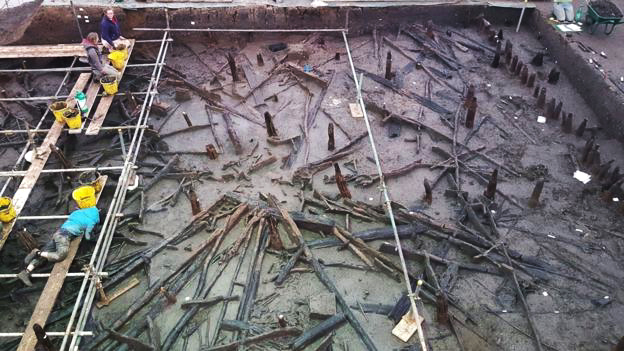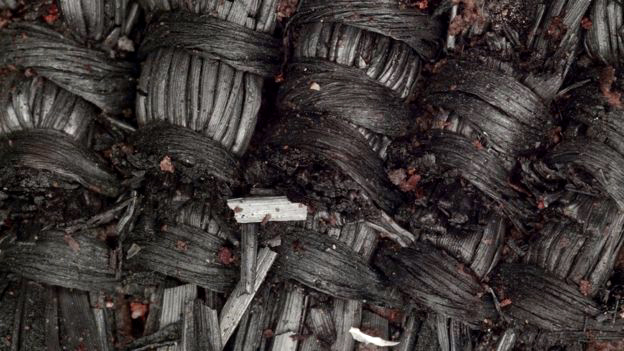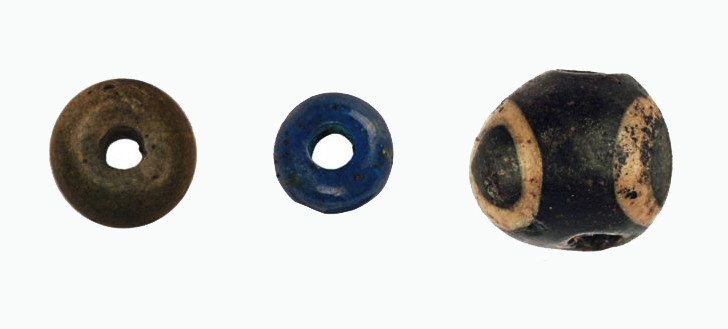


An online article by Kayleen Devlin for the BBC - Bronze Age houses: What the finds tell us - reports on the discovery of Britain's 'Pompeii' at a quarry in Cambridgeshire, UK.

Images: Cambridge Archaeological Unit
A number of well-preserved dwellings dating back to the Bronze Age with artefacts reveal new details about the period between 2500 and 2000BC and those who lived through it.
One of the finds at Must Farm quarry in Cambridgeshire were pots still containing food. According to Selina Davenport, an archaeologist who helped uncover the Bronze Age dwellings, the find suggests that the pots were being used to make pottage.

This site has provided new evidence, such as the Bronze Age people's woodwork skills and knowledge of timber; sophisticated woodworking joints as well as evidence of woodland management.
The discovery of textiles made from plant fibres such as lime tree bark suggests those living in the Bronze Age were skilled in the use of a range of different materials.

An earlier excavation at the Must Farm quarry uncovered exotic glass beads - from the Balkans - that formed part of a necklace, not usually associated with the Bronze Age and suggesting trading between continents.
The settlement discovered at Must Farm quarry is made up of circular wooden houses, built on stilts, and dates from about 1000-800 BC.
A fire destroyed the posts, causing the houses to fall into a river where silt helped preserve the contents. Archaeologists at the site think they have found five houses but are not yet certain.
Archaeologists working at the site agree that this discovery represents a rare snapshot - a moment in time.
by Bradshaw Foundation
Monday 04 December 2023
by Bradshaw Foundation
Friday 30 June 2023
by Bradshaw Foundation
Thursday 06 April 2023
by Bradshaw Foundation
Thursday 24 November 2022
by Bradshaw Foundation
Tuesday 27 September 2022
by Bradshaw Foundation
Thursday 08 September 2022
by Bradshaw Foundation
Tuesday 19 July 2022
by Bradshaw Foundation
Monday 06 June 2022
by Bradshaw Foundation
Friday 11 March 2022
by Bradshaw Foundation
Wednesday 02 March 2022
by Bradshaw Foundation
Thursday 26 August 2021
by Bradshaw Foundation
Monday 16 August 2021
by Bradshaw Foundation
Tuesday 06 July 2021
by Bradshaw Foundation
Thursday 06 May 2021
by Bradshaw Foundation
Thursday 06 May 2021
by Bradshaw Foundation
Tuesday 16 March 2021
by Bradshaw Foundation
Monday 04 December 2023
by Bradshaw Foundation
Friday 30 June 2023
by Bradshaw Foundation
Thursday 06 April 2023
by Bradshaw Foundation
Thursday 24 November 2022
by Bradshaw Foundation
Tuesday 27 September 2022
by Bradshaw Foundation
Thursday 08 September 2022
by Bradshaw Foundation
Tuesday 19 July 2022
by Bradshaw Foundation
Monday 06 June 2022
by Bradshaw Foundation
Friday 11 March 2022
by Bradshaw Foundation
Wednesday 02 March 2022
by Bradshaw Foundation
Thursday 26 August 2021
by Bradshaw Foundation
Monday 16 August 2021
by Bradshaw Foundation
Tuesday 06 July 2021
by Bradshaw Foundation
Thursday 06 May 2021
by Bradshaw Foundation
Thursday 06 May 2021
by Bradshaw Foundation
Tuesday 16 March 2021
Friend of the Foundation











